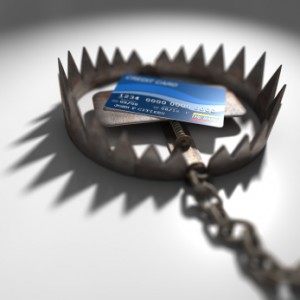Hint: It’s not about your loan interest rates.
You want to get out of debt so you can reduce your risk, increase your cash flow, and have greater peace of mind, right? Here’s the fastest and safest way to do it:
1. Roll Non-Deductible Loan Interest into Deductible Loans
Assuming you have enough home equity and good enough credit, refinance your mortgage and roll as much of your non-deductible loans (credit cards, auto loans, etc.) into it as possible. The tax deduction will increase your cash flow.
2. Roll Short-Term, High-Interest Loans into Long-Term, Low-Interest Loans
Again, the goal is to minimize your interest payments and maximize your cash flow. Then, you can attack your remaining debt strategically, using your increased cash flow to eliminate one loan at a time.
CAUTION: Do NOT do this if you’re undisciplined and your spending is out of control. If you’re just going to charge your credit cards back up again, you’ll just sink deeper into debt.
3. Improve Your Credit Score
There are tons of companies and resources to help you do this. By increasing your credit score you get better loan interest rates, which lowers your payments and puts more money in your pocket.
4. The Secret Sauce: Cash Flow Index
Here’s where the rubber hits the road. After minimizing your payments and maximizing your cash flow, you’re now prepared to focus on one loan at a time, thus creating the “snowball effect” until you’re completely debt-free.
Most financial advisors and pundits will tell you to pay off your loans with the highest interest rates first.
My advice is to ignore the interest rate and use my Cash Flow Index to determine which debt to pay off first.
To determine your Cash Flow Index, take all your various loan balances and divide each of them by their respective payments. Whichever one has the lowest number is the one you should pay off first.
For example:
Home Loan Balance: $228,000
Interest Rate: 7%
Monthly Payment: $1,665
Cash Flow Index: 137 ($228,000 ÷ $1,665)
Auto Loan Balance: $16,500
Interest Rate: 8%
Monthly Payment: $450
Cash Flow Index: 37
Credit Card Balance: $13,000
Interest Rate: 12%
Monthly Payment: $260
Cash Flow Index: 50
Student Loan: $107,000
Interest Rate: 3.9%
Monthly Payment: $650
Cash Flow Index: 165
In this example, it seems to make sense to pay of the credit card first because it has the highest interest rate. But the Cash Flow Index reveals that the auto loan should be paid off first.
The trick is to pay off debt that gives you the greatest cash flow with the least investment.
A high Cash Flow Index means your loan balance is high relative to the payment, while a low Cash Flow Index means your balance is low but with a high payment. Knock out those high payments first and you free up cash to work on other debts.
In this case, by paying off the auto loan first, you free up more monthly cash, which can then be applied toward the credit card balance.
Paying off the auto loan first means you can pay off both faster than if you started with the credit card.
The Risk Factor
This strategy isn’t just about paying off debt faster—it’s also about reducing your risk.
Banks and other financial institutions tell you to pay off debts that lessen their risk while increasing yours.
For instance, if you put more equity into your home, you are still at risk for being foreclosed on if you can’t make a payment. In fact, they may be more willing to foreclose if you have more equity in your home.
Ask yourself the following questions:
- How often do banks want your money?
- How much of your money do they want today?
- For how long do they want your money?
- What incentives do they offer to either have you pay off debts faster or save money with them longer?
Banks play by much different rules than they teach us. You need to see through their advice to understand who it serves, then do what is in your best interest, not theirs.
So here’s the formula:
Be strategic about your credit score and existing loans and liabilities to minimize your interest payments and maximize your cash flow.
Ignore your loan interest rates and instead, use the Cash Flow Index (loan balance divided by payment) to determine which loans to pay off first. Start with those with the lowest Cash Flow Index.
Pay off one debt, then use your increased cash flow to pay off the next, and so forth until you’re debt-free.
*******************************
 Garrett Gunderson is an entrepreneur, financial coach, the founder of Freedom FastTrack, and the primary author of the New York Times bestseller Killing Sacred Cows: Overcoming the Financial Myths that are Destroying Your Prosperity.
Garrett Gunderson is an entrepreneur, financial coach, the founder of Freedom FastTrack, and the primary author of the New York Times bestseller Killing Sacred Cows: Overcoming the Financial Myths that are Destroying Your Prosperity.
Garrett loves inspiring others to turn their potential into production. He has dedicated his life to living and teaching a unique concept known as Soul Purpose that reveals how anyone can live a more prosperous and rewarding life.
As a finance and business productivity coach, Garrett instructs both large and small groups of business owners and financial service professionals nationwide.






Speak Your Mind
You must be logged in to post a comment.